

This blog post is the fifth in a series focusing on members of the Index staff. Today we introduce Pamela Patton.
What is your background and specialization?
I’m a medievalist who studies the visual culture of the Iberian Peninsula, a focus that began at Tufts University when my advisor Madeline Caviness pointed me toward the Pamplona Bibles as a research topic. I was fascinated, and still am, by the complexity of medieval Iberian culture and its historiography—the questions are constantly evolving. The decision served me well: after doing grad degrees at Williams College and Boston University, I was offered a fellowship at Southern Methodist University in Dallas, which then evolved into a split curatorial and faculty position in “Spanish Art.” Although I shifted out of curatorial work after tenure, as a professor at SMU I was able to develop several courses on medieval Iberia as well as other aspects of the Middle Ages. Since coming to the Index in 2015, I’ve continued to research and occasionally teach medieval Iberian things, and I’m always happy to pitch in on cataloging works of art from Spain for the database. After 30+ years in the field, I do occasionally wonder if I should wander into some other part of the world, but then some great new Iberian question turns up, and back I go.
What research projects are you working on currently?
I’ve just wrapped up a project on how skin color and stereotype were used in thirteenth- and fourteenth-century Iberia to signal racial, social, and cultural difference, and that’s inspired me to think further about the role of improvisation generally in Gothic manuscript illumination, specifically in the illustrated manuscripts of the Cantigas de Santa María, which were made for Alfonso X of Castile in the late thirteenth century. Illustrating the four hundred songs that were to be included in those two manuscripts must have been a massive task, and the artists met the challenge with some highly inventive iconography—giant silkworms, flying chairs, dancing pork chops, and the like. They must have had considerable latitude, in addition to a wonderful imagination!
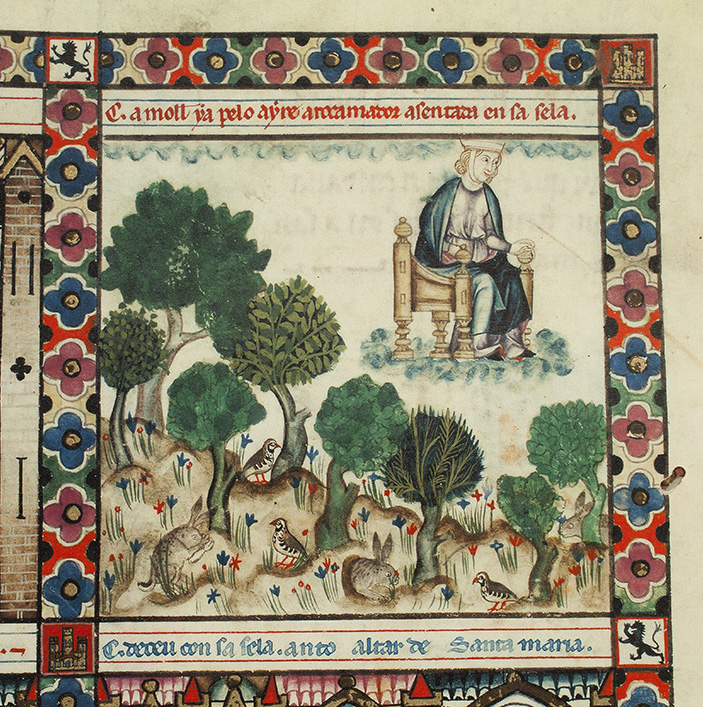
What do you like best about working at Princeton?
Princeton does things for real. Very few universities so effectively hold teaching and research at their core, not to mention committing the resources that help them happen. As Index director, I especially appreciate the openness to new ideas, the support for scholarly initiatives, and the extraordinary research resources. These things don’t happen by themselves; they take investment at the highest level. On a more personal note, I’m grateful every day that when I go to work I have the opportunity to hear and share ideas with so many bright, thoughtful people, both in the Index and throughout campus, and in such a beautiful place. It’s a fine reason to get up in the morning.
What travel experience played a role in your becoming an art historian?
My mother had always wanted to travel, and when I was a child she and my father twice managed to put aside enough money to take the whole family to Europe. Remember Arthur Frommer’s Europe on $10 a Day? My mother really did that. I loved visiting all the art museums and historic sites, but I think reading The Hobbit on the train between cathedral towns in England was probably what made me a medievalist. The line between history and fantasy obviously was very blurry for me then, but somehow I became absolutely certain I wanted to learn more about this stuff. Corny, okay, but give me a break—I was eleven.
What do you like best about being back on campus in person?
People and books. I really missed the easy discourse that comes with sharing a coffee, talking over a research question, or listening to Q&A after a lecture. Ideas flow so much more freely when you’re in person and the moment has your full, active attention. And there is nothing more inspiring than walking into the library stacks to find the physical book you need: the excitement of spotting and opening it; the anticipation of what you’ll find in its pages; the serendipity of seeing what else is on that shelf. And the lights! I really like how the lights in Firestone brighten gradually when you walk into an individual aisle. It’s as if the light bulb that’s about to go off in your head is already going off all around you.
Coffee or tea?
Yes, please, all of it. I would drink coffee all day if I could, especially if it’s the cortados that I got hooked on during dissertation research in Spain. But to spare my co-workers a jittery colleague, in the afternoon I usually segue into tea, ideally a nice green jasmine.
This blog post is the fourth in a series focusing on members of the Index staff. Today we introduce Catherine Fernandez.
What is your background and specialization?
As a medieval art historian, I owe so much of my intellectual formation to the universities where I earned my degrees. Can I use this space to give a shout-out to all the medievalists—both past and present—at Florida State University and Emory University? My academic journey, so to speak, began at FSU with two BAs, one in English Literature and one in Art History. I earned my PhD in Art History at Emory and then headed up the east coast to join the Index research staff immediately after graduation. My current research interests center on medieval treasuries and French Romanesque art, but I am happy to get my thousand-year medieval “fix” through various Index projects. Based on cataloguing or classroom instruction needs, I might be simultaneously working on an Ottonian manuscript, a late-antique sarcophagus, or Gothic archivolts; it’s an embarrassment of riches.
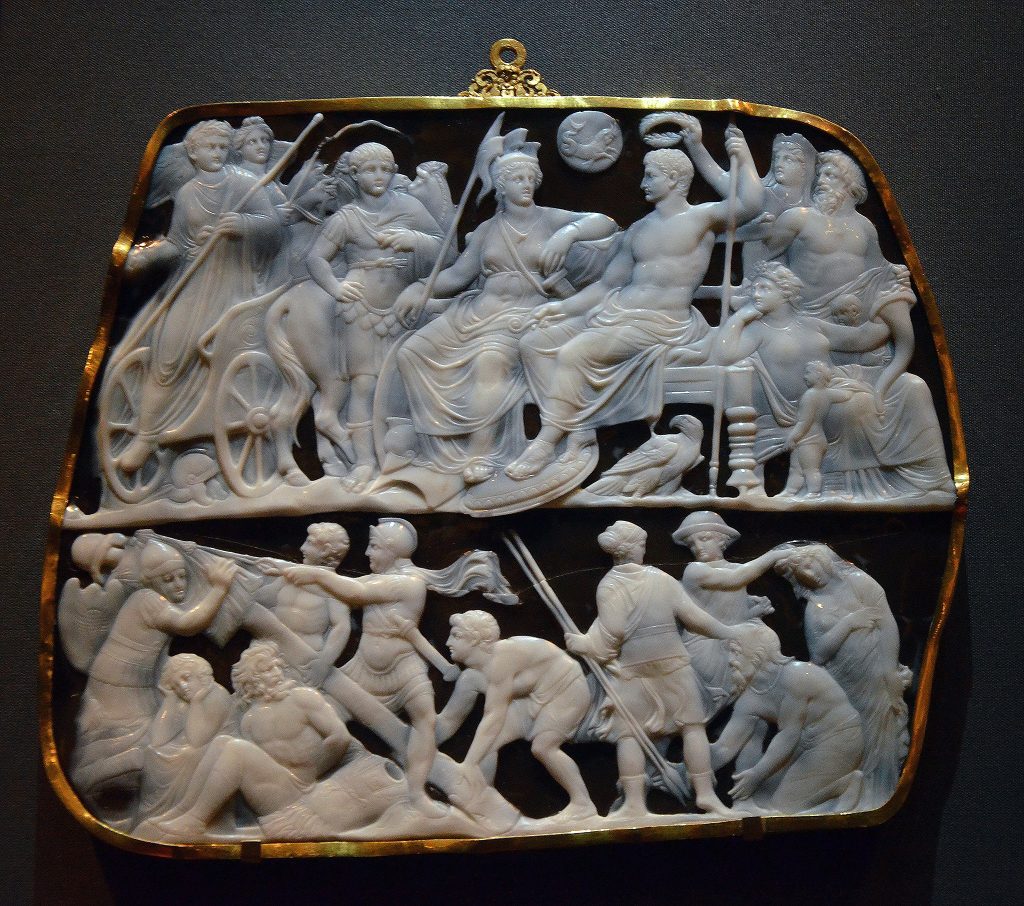
What research projects are you working on currently?
At the Index, I happily embrace a wide range of topics, but I am particularly thrilled to have worked with our IT guru Jon Niola in the development of a field within individual records that “maps” iconographic programs within medieval buildings and other structures. By highlighting the placement of in-situ works of art, the “Location in Structure” field can only amplify our understanding of medieval iconography’s spatial dimension. With regard to my own research, I am currently working on my book project, entitled Charlemagne’s Pectoral: The Presence of Carolingian Memory at Saint-Sernin of Toulouse. This monograph seeks to reintegrate a group of extraordinary treasury objects associated with the emperor Charlemagne within the liturgical space of the famous Romanesque shrine.
What do you like best about working at Princeton?
It remains an absolute pleasure to work with so many wonderful medievalists—both members of the local community and visiting scholars—and participate in the “Life of the Mind” on campus.
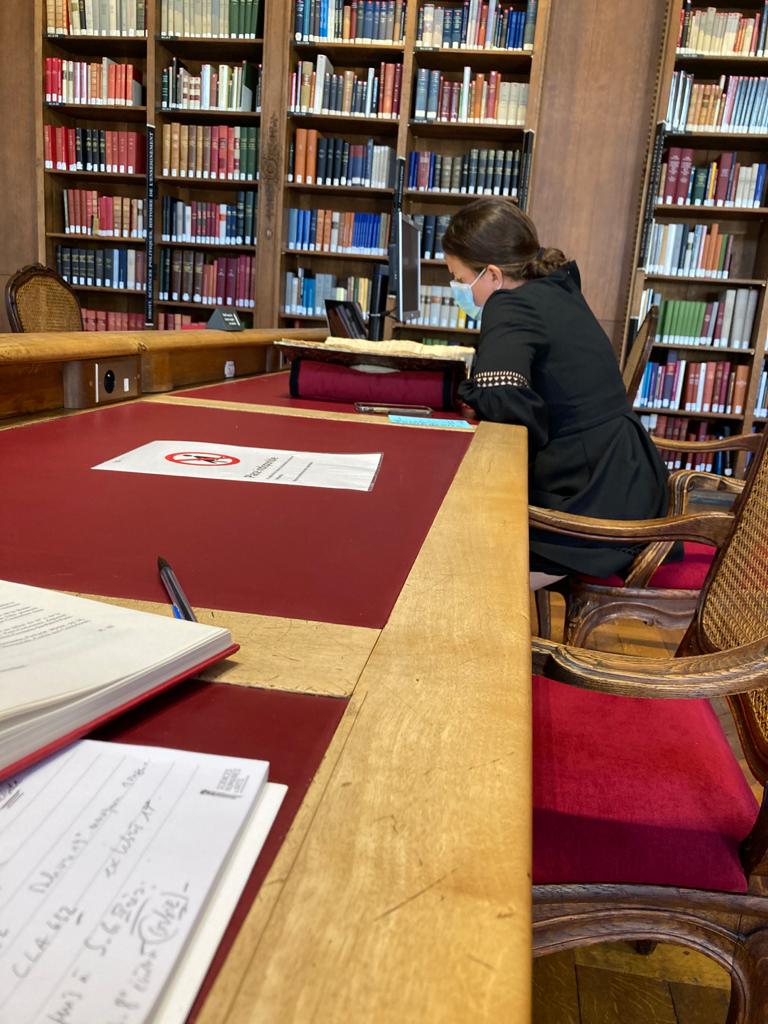
What travel experience played a role in your becoming an art historian?
I consider myself fortunate to have had an upbringing that included extensive global travel. Over the course of my childhood, my family visited countless monuments, museums, galleries, and archaeological sites around the world, and any number of these places could have infected me with the “art history bug.” But humor me, if you will, when I give credit to the Metropolitan Museum of Art and E.L. Konigsburg’s novel From the Mixed-Up Files of Mrs. Basil E. Frankweiler. I mean, what art historian hasn’t fantasized about hiding out at the Met like the novel’s two child protagonists?
What do you like best about being back on campus in person?
Close access to actual libraries and actual human beings, as I am rather fond of both.
Coffee or Tea?
Red Bull. Blueberry flavored. What? Was I supposed to wax poetic about some kind of refined oolong?
This post is the third in a series focusing on members of the Index staff. Today we introduce Henry D. Schilb.
What is your background and specialization?
Maybe I ought to have been a musicologist. Among other things that I almost got away with in my life, I once wrote, produced, and hosted a radio series about twentieth-century music. That was during the fifteen years that I worked as an announcer at a couple different public radio stations (among many other brutally low-paying jobs I’ve held down, often two or more at a time). In those heady days, I sneaked works by Ruth Crawford Seeger, Harry Partch, Iannis Xenakis, György Ligeti, Pierre Boulez, George Walker, and even James Tenney onto the airwaves, no mean feat at that time. Oh, how invigorating were the listener complaints! No composer younger than Brahms was safe from the acrid contempt of the average public radio listener, but I still especially cherish being told by one listener that I myself was what was wrong with the world—and this was in the early ’90s, so the listener who lodged that complaint had no idea what was coming!
Although I always fear that too many minds nestled between incurious ears remain impervious to the pleasures of new music, or simply unaware of them, let me hope that there are some—among those who have survived more than twenty percent of the twenty-first century with a spirit of adventure intact—who will forgive me for seizing this moment to direct their attention to the music of George Lewis, Chaya Czernowin, Unsuk Chin, Rebecca Saunders, and Olga Neuwirth. I could go on, but that’s a good start. You can thank me later.
But, for some reason, I’m an art historian now. I earned my PhD at Indiana University in 2009, and I specialize in late-Byzantine art, and embroidered liturgical textiles in particular. Yeah, I’m a real hoot at neighborhood parties.
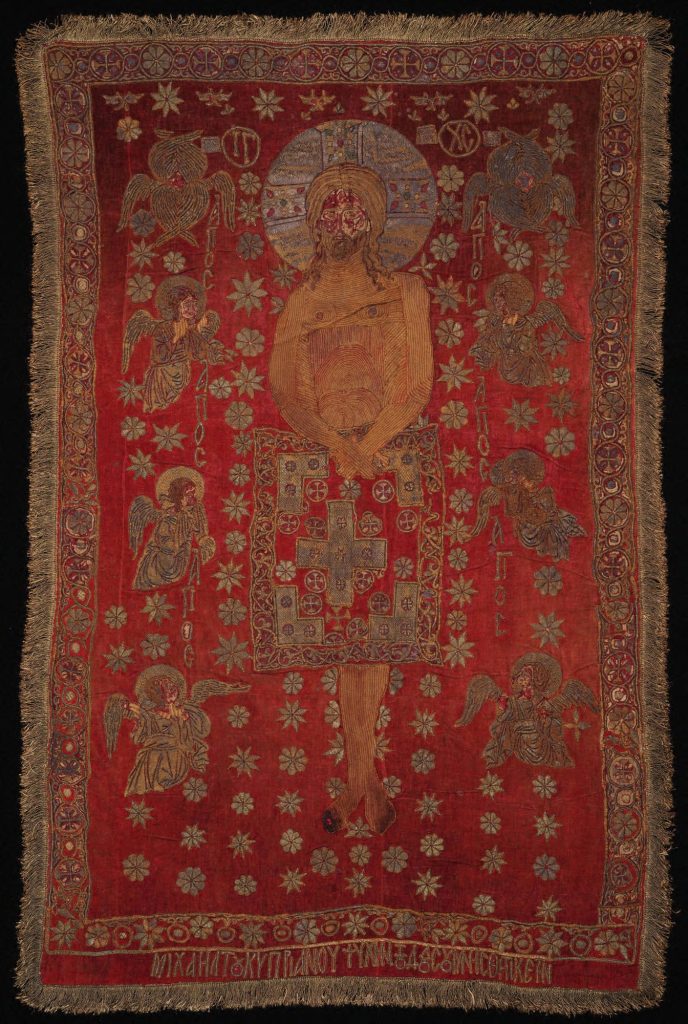
What research projects are you working on currently?
Quite by mistake, I find myself the resident geographer at the Index of Medieval Art. Maybe I spend too many of my waking hours thinking about how to deal with location information in our database, but I rather like that part of my job. In my own research, however, I still focus on embroidered veils. Back in November, I presented a paper at the Index’s conference on “Fragments, Art, and Meaning in the Middle Ages.” I discussed, among other objects, a textile in the Princeton University Art Museum. I’m also optimistically planning a trip to Canterbury Cathedral to visit a post-Byzantine textile that has a very strange history indeed. Remind me to tell you about it sometime.
What do you like best about working at Princeton?
Even after ten years at Princeton, I still think it’s pretty cool to work at the same university where Roger Sessions taught for many years. (Yes, he’s another composer whose music I love.) Also, I like to go for a long run after work, down to the towpath, along the canal, and then back up through campus, through the majestic arches and under the leafy canopy. Like me, the campus is at its best in October.
What do you like best about being back on campus in person?
Although I thrived while working from home during the pandemic, and my productivity really went through the roof, I suppose that the return to campus back in September was inevitable. As for what I like best about The Return, I’ll simply refer you to my comments above regarding running through campus. I have to say, however, that the experience now can be rather spoiled by all the construction…and those danged scooters.
What travel experience played a role in your becoming an art historian?
My honest answer to this question is boring. It’s also probably cheating. It was not a literal journey, you see, but a slide show in the first art history course that I took in college in 1984. So, the first time I looked closely at a picture of Hagia Sophia in Istanbul—that’s what’s really to blame for my being at the Index of Medieval Art today.
But I’ve been traveling all my life. I said my first word at Expo 67 in Montreal. Well, two words, technically, I guess. What I said was “egg roll.” And I meant it.
Of course, destiny-shaping travel needn’t take you any great distance. When I was a kid in Lockport, Illinois in the ’70s, every trip to the Field Museum in Chicago felt like a profoundly life-altering experience. I still keep a pair of Mold-A-Rama dinosaurs in my office at the Index.
Mold-A-Rama? Google it.
When I lived in England in the late ’80s, I used to love to take a drive to Little Gidding, just to hang out, wander around, listen to the wind, ponder the landscape, and to think about poetry, music, history, and…just to think. I was always surprised that I never encountered another visitor there. Every trip to Little Gidding was very different from the Bloomsday I spent in Dublin, which must have been in ’89. You couldn’t sneeze without jostling some other tweedy nerd trying to wash down a gorgonzola sandwich with a glass of burgundy.
On research trips, I still always try to do something just for fun, something that has nothing to do with my research—even nothing to do with art history—but everything to do with who I am, so one of my favorite travel experiences was a visit in 2005 to Sighișoara, Romania, the birthplace of Vlad the Impaler. Good times!
Coffee or tea?
Yes, please.
This blog post is the second in a series focusing on members of the Index staff. Today we introduce Jessica Savage.
What is your background and specialization?
I am an Art History Specialist and Index cataloger of Western medieval art, specializing in the art of the medieval book in the later Middle Ages. My research focuses on topics of allegory, gender and personification, and text/image relationships, especially the deep-rooted iconography of personified virtues as they appear in the Psalms. My background is in studio art, and I initially trained as a painter and printmaker at Pratt Institute in Brooklyn, New York. My first art history survey course at Pratt, now twenty years ago, commenced with a discussion of the Venus of Willendorf and you could say I haven’t looked back since! I completed my postgraduate training at Christie’s Education in London and earned my MLitt degree in the History of Art from the University of Glasgow. Here, I wrote my thesis on the iconography of local popular saints depicted on pilgrim’s souvenirs in late medieval England. In 2010, after briefly working as a manuscript specialist for an auction house in New York, I joined the Index to research manuscripts for the joint digitization project undertaken by the Index and the Morgan Library & Museum. This was an enriching start to my Index career, which allowed me great digital access to remarkable manuscripts and their iconography. Later, I pursued an education in library and information science at Rutgers and earned my MLIS degree with a focus on archives.
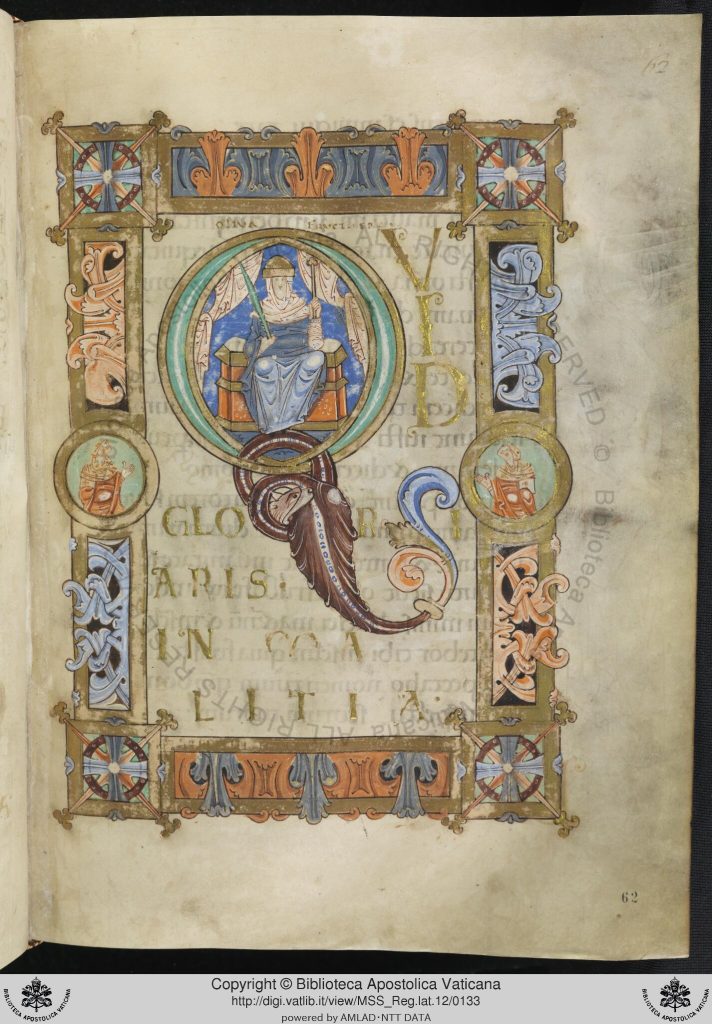
What research projects are you working on currently?
For the Index, I continue to catalogue illuminations of late medieval manuscripts photographed by James Marrow, Princeton History of Art Professor Emeritus, as well as contribute research for items in the Index card catalog not yet entered into the database, focusing on manuscripts and ivory objects. I am working on a few independent research projects for various conferences and publications. My first project, in collaboration with scholars at the University of Tübingen, is an article on the almsgiving Charity figure, wearing the olive-tree crown, in the forthcoming volume “Personifications in Text and Image.” This study looks at the expression of this charitable personification in an early medieval illuminated Psalters and considers their representational potential and role in conveying meaning. A second project considers a little studied illuminated Prayer Book made in Prague for King George of Poděbrady (r. 1458–1471). The manuscript was made and presented to the king in the year 1466 and is now housed in the Morgan Library & Museum in New York as MS. M.921. This research focuses on the visual relationships within the small cycle of devotional illuminations produced at the fifteenth-century Bohemian court under queen Joanna’s patronage. In early May, I’ll be presenting in the sponsored session of the Society for Emblem Studies at the virtual Kalamazoo conference with new work on the medieval sources of emblematic images inscribed with psalm verse and finding their subject standards.
What do you like best about working at Princeton?
I like best that my days at the Index are full and interesting. Some days I spend looking at an object in our subject card catalog and photographic archive, making trips to the library to check bibliographic references, or answering a research question. Other days I might be editing images, or cleaning data so it is more easily searched in the database. The angles to searching Index information are adaptive, and it’s rewarding to find a new route to discover parts of the collection and share these finds with researchers and colleagues. Moreover, Princeton fosters a supportive environment for research and learning with lectures, workshops, and conferences in any number of topics.
What travel experience played a role in your becoming an art historian?
There were several travels as a graduate student in the UK that played a role. However, one unexpected experience was more recent and closer to home. A few months ago, I rediscovered a statue of the Czech theologian, Church reformer, and martyr Jan Hus (1369–1415) in my hometown on Long Island. The statue of Hus, holding a chalice (the symbol of Utraquist belief in full communion), was erected in Bohemia, New York in 1893. It is known to be one of only two statues of Jan Hus in the United States and it predates the establishment of the Hus memorial in Prague’s Old Town Square by twenty-two years. I am currently researching the 1466 Prayer Book of George of Poděbrady (Morgan Library & Museum, MS. M.921), belonging to George, the Utraquist king of Bohemia, who ruled in the turbulent decades after Jan Hus’s death in 1415. I found it a happy occasion to pay a visit to the important local statue!
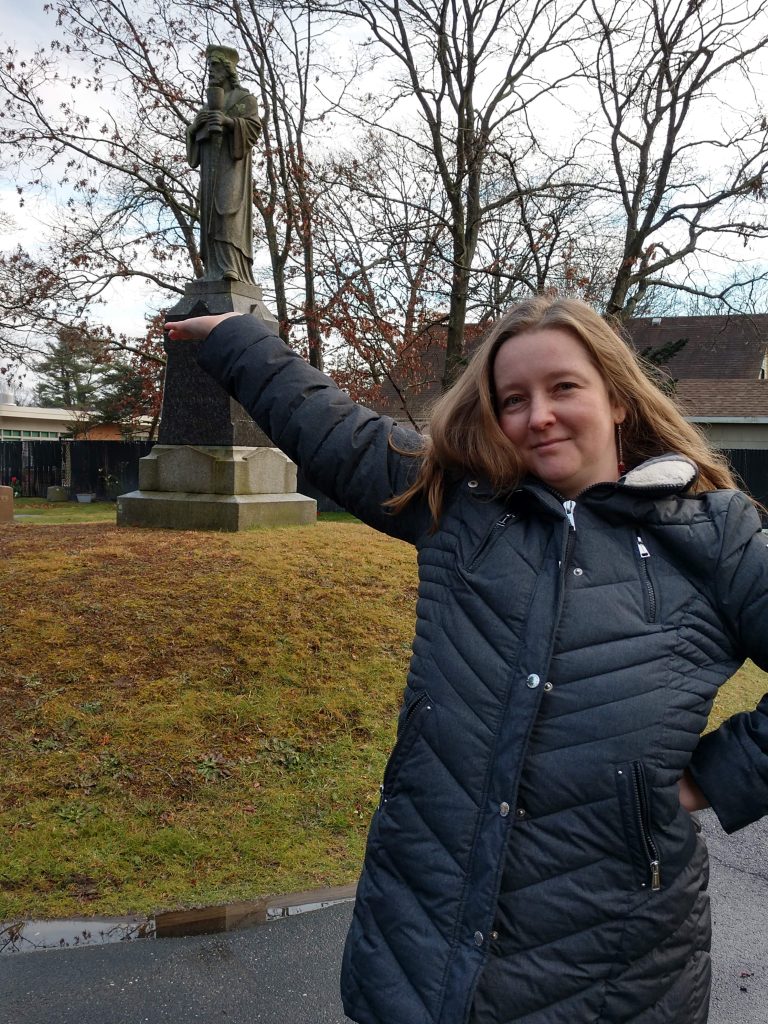
What do you like best about being back on campus in person?
After a long separation from the archive and face-to-face conversation with colleagues, it’s wonderful to be back on campus and in the vibrancy of the Princeton community again. What I like best about working at the Index is the comradery over our projects and the rigor of the schedule, which makes every day feel like you’re adding to the pot of progress. It’s also been great settling into our new temporary space in Green Hall and being close to Firestone Library.
Coffee or tea?
I drink tea most days and will have coffee, especially an espresso, on occasion. My regular teas are smoky Earl Grey, oolong tea, and an aged black tea from China called Pu-erh. I believe you also can’t go wrong with the perfect cuppa and enjoy the Yorkshire Gold breakfast variety for that. Teas are wonderful from the blending to the infusion process. I’d almost say, it’s an art!
This blog post is the first in a series focusing on members of the Index staff. Today we introduce Maria Alessia Rossi.
What is your background and specialization?
I joined the Index of Medieval Art initially as a Postdoctoral Researcher, and starting in September 2019, as an Art History Specialist. I earned my BA in History of Art from ‘La Sapienza’ University of Rome and my MA and PhD from The Courtauld Institute of Art. I work on medieval monumental art in the Byzantine and Slavic cultural spheres, cross-cultural contacts between the Eastern and Western Christian worlds, and the role of miracles in text and image.

What research projects are you working on currently?
For the Index, I research a wide range of medieval topics, but in my individual research and publications, I have been fascinated for a long time by the role of miracles in medieval society. During the Middle Ages, miracles played a crucial role in theology and propaganda, mirroring the needs, struggles, and desires of every social class. I have been surveying Christ’s miracles in late Byzantine churches in Constantinople, Mystras, Thessaloniki, Mount Athos, Ohrid, and Kastoria, and pairing the visual evidence with textual commissions, dealing with miracles of contemporary and older saints. The underlying question is what does the interconnectedness of visual and literary evidence dealing with miracles tell us about the contemporary social, religious, and political circumstances? One major outcome of this is a monograph tentatively titled Visualizing Christ’s Miracles: Art, Theology, and Court Culture in Late Byzantium.
Another topic I am passionate about is the rich, yet little-known art and architecture of Eastern Europe between the thirteenth and seventeenth centuries. Modern borders, patterns of polarizations, and ideological barriers have prevented scholars from seeing a fuller and broader picture of these regions. Yet their geographical, religious, political, and cultural histories prove the interconnectedness of those territories at the crossroads of the Byzantine, Mediterranean, and Western European cultural spheres.
In this spirit, I co-founded the initiative North of Byzantium (NoB) with Alice I. Sullivan, a project sponsored by a 3-year grant from the Mary Jaharis Center for Byzantine Art and Culture, and the digital platform Mapping Eastern Europe. The aim is to place Eastern Europe on the map of art history by fostering a dialogue between scholars, promoting a sense of community, and facilitating research, teaching, and the study of its visual culture among students, teachers, scholars, and the wider public.

What do you like best about working at Princeton?
What I like best about working at Princeton University, and specifically at the Index of Medieval Art, is the people! There is a unique and constant inflow of scholars and students from all over the world who come to use the Index card catalogue and database. As an Indexer, you learn about their fascinating work, you help them find new materials and discover the Index, and you get excited with them when they stumble across unexpected finds. Scholars also gather to attend the Index conference, and this is yet another opportunity to discover recent and original research and engage in exciting conversations. Every year we also see our medieval community growing, with the arrival of new students and fellows, coming in with new topics, questions, and iconographic riddles to be resolved!
What travel experience played a role in your becoming an art historian?
Ever since I was little, my parents have taken me along on their trips. But did our vacations include beaches or time off? No, they were an endless list of archaeological sites, museums, and cities to explore. This usually meant that lunches had to be delayed to accommodate the busy schedule that ended up always (and I do mean always) including the main archaeological sites between noon and two p.m. under the burning hot sun! You would expect this to have turned me away from art and archaeology, yet here we are…. In time, these trips became research-focused, and the schedule became packed with Byzantine art and architecture. On one of these occasions, we made it to the remote location of a fortress built in the fourteenth century by the Serbian king Milutin. Of course, we were exhausted, and it was the middle of a very hot summer day, but I was absolutely overjoyed (as you can see in the photo). At that moment I knew there was no going back!
What do you like best about being back on campus in person?
The best part of being on campus is resuming the conversations and debates that make the Index thrive, and with it, the Middle Ages. Screens and planned meetings have not allowed for many of the spontaneous interactions that are at the heart of what the Index is about. When we are cataloguing, working on taxonomy, or implementing changes in our browse lists, we encounter issues and questions that benefit from broader conversations with the other specialists at the Index, such as how do we differentiate between James Major, James Minor, and James Brother of the Lord, or would it be better to use scroll or roll in our controlled vocabulary? We have weekly meetings where we discuss for hours (not ideal with zoom-fatigue during the pandemic!) the topics that we have encountered during the week. And when you visit us at the Index, you may even catch us in the middle of impromptu conversations in the corridor, sipping cups of coffee or tea, and chatting about the role of Tristan’s dog, Hodain, in the Legend of Tristan and Isolde, or about what work of art we should catalogue next and why.
Coffee or tea?
It’s tough…. Being Italian I would be tempted to say that nothing beats a good cappuccino! However, I do love my tea. And by “tea” I mean any kind of infusion, including Earl Grey, matcha, mint tea, hibiscus, jasmine, and the Tough Chai from Small World, our local coffee shop. I love trying new teas and talking about tea. So yeah, probably my answer would have to be tea!
The Index staff is pleased to announce the relaunch of the Index’s digital image collections, which have recently undergone a massive upgrade. The updated platform hosts ten collections of images generously donated to the Index and made freely accessible to the public through the Index website. These unique documentary resources include more than 50,000 images of medieval art and architecture and reflect the varied interests and travels of their twentieth-century photographers. They represent a range of subjects, techniques, and media, including English medieval embroidery, medieval and Byzantine manuscripts, European choir stall sculpture and stained glass, and Gothic and Romanesque architecture.
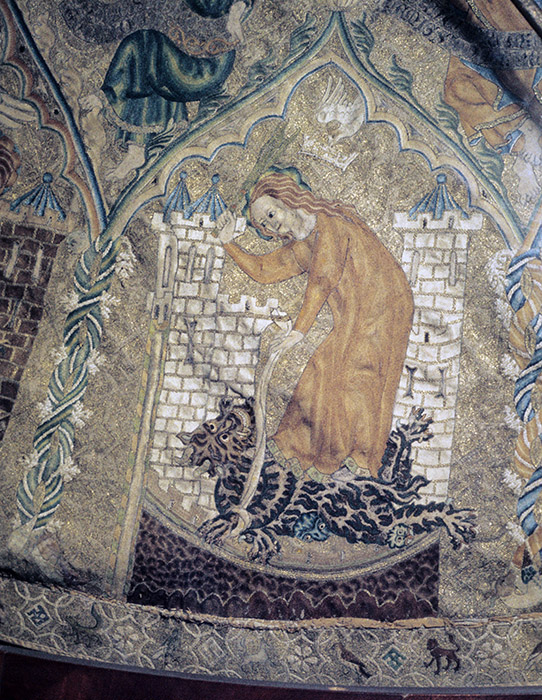
Although the images in these collections have not been cataloged with the same level of detail as those in the iconographic database, every effort has been made to assign them basic information regarding location, date, and in many cases, iconographic subjects. The latter can be found in browse lists that include a variety of iconographic topics, including saints and martyrs, animals, zodiac, occupations, and secular and religious scenes, all updated to follow the current subject standards of the main Index database. Browsing these subject lists reveals much about each collection. For instance, the subject list for the “Opus Anglicanum” database—an image collection of medieval English needlework on ecclesiastical and secular textiles—includes numerous saints especially venerated in England, with multiple scenes for Margaret of Antioch, Nicholas of Myra, and Thomas Becket.
Browsing the subject list of another collection, the Elaine C. Block database of misericords, reveals the wide variety of drôleries that decorated the wooden under-seat structures: fantastic creatures, battling animals, and figures playing in sports and games, engaged in occupations, or enacting proverbial lessons. John Plummer’s database of medieval manuscripts includes large numbers of biblical and apocalyptic images, including scenes with Christ, David, and the Virgin Mary, and other popular saints found in late medieval prayer books. The subjects in Plummer’s collection closely resemble those found in Jane Hayward’s collection, perhaps reflecting the shared interests of two scholars were curators at major collections in New York City during the second half of the twentieth century.

The Gabriel Millet collection comprises the study and teaching images of that scholar, an important archaeologist and historian of the early twentieth century who specialized in Byzantine art. Subjects represented here include multiple biblical figures and scenes, but also Byzantine generals and emperors and several text subjects, such as the Chronicle of Manasses and the biblical psalms by number.
The Gertrude and Robert Metcalf Collection of Stained Glass is a documentary treasure for the study of Gothic stained glass. The Metcalfs, who were both stained glass artists and experienced photographers, took more than 11,000 images of stained glass from European monuments, covering sites in Austria, England, France, Germany, and Switzerland. Their images of stained glass windows are a fascinating record of a fragile artistic medium, captured during fragile times. Their travels coincided with the dawn of World War II in Europe over the years 1937 and 1939, and they produced a body of documentary evidence that became critical to postwar restoration efforts. A look at the Metcalf subject list reveals many of the expected themes in medieval iconography, but also significant iconographic cycles for several French bishops, such as Austremonius and Bonitus of Clermont, Germanus of Auxerre, and Martialis of Limoges.
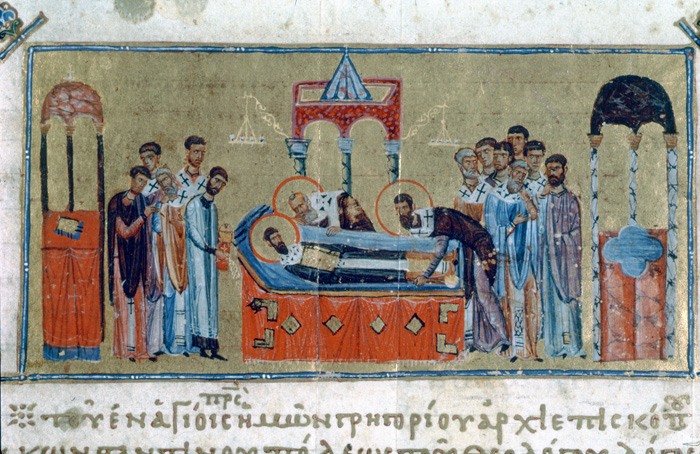
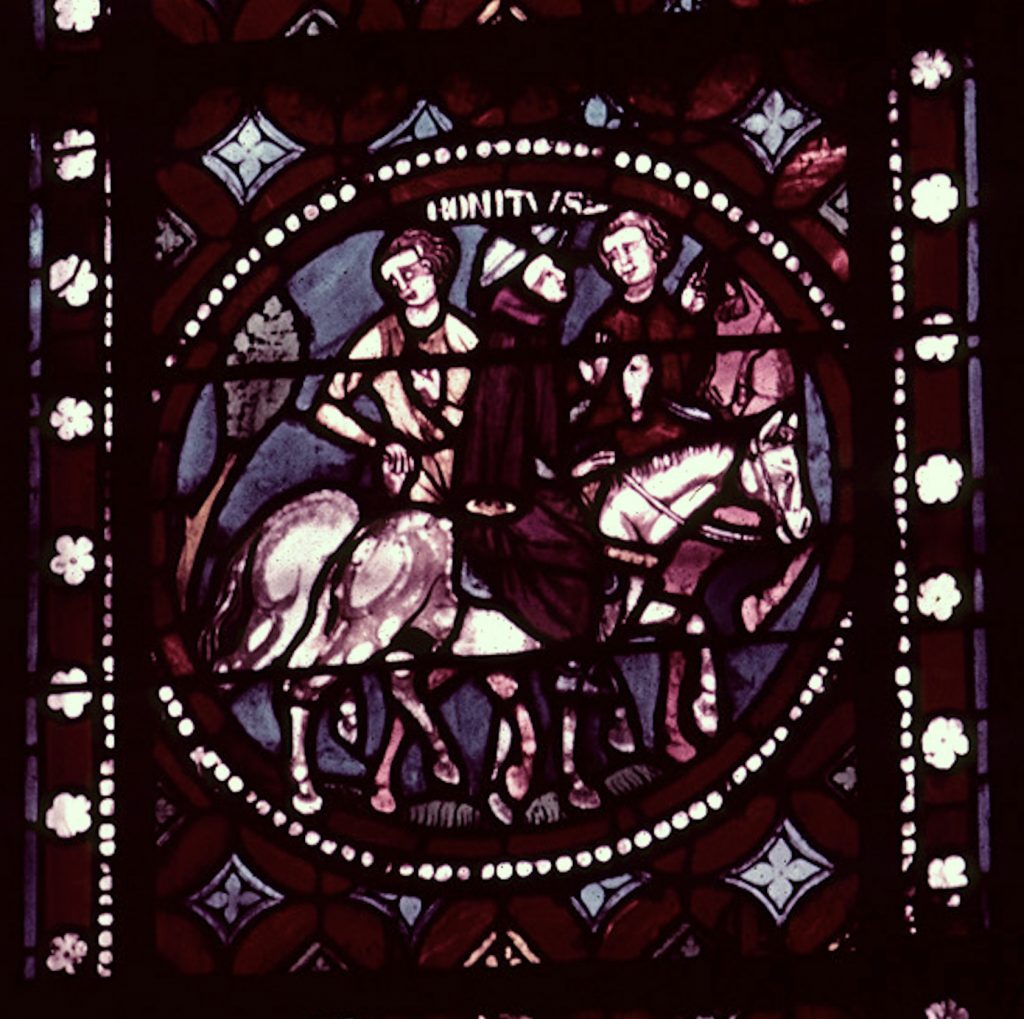
Geographically, the collections cover country and city locations in four continents—Europe, Africa, Asia, and North America—from obscure sites to famous ones, and they include many types of repositories, from in-situ locations to museums, libraries, and private collections. To better accommodate browsing by region, locations in all the collections have been formatted to begin with the country. Each collection is introduced with general information about its history, scope, and image use policies. It has been satisfying to edit and release these collections—now with more consistent information and a more secure digital platform—knowing that they are now more useful to scholars. Your feedback on the collections is welcome via this form.
Continuing a series of blog posts introducing the new features of our online database.
The Index of Medieval Art database catalogs more than 26,000 subjects. For a long time, you could explore this vast taxonomy only by browsing the subject headings in alphabetical order. To make the data more accessible, the Index has developed a Subject Classification browse tool, which allows researchers to discover Index holdings by browsing through various categories of our hierarchical classification of subjects.
In this network, subjects are grouped under five top-level headings:
By browsing the contents of these categories, researchers can learn more about Index subjects as grouped by theme. Researchers interested in the “History” category, for example, will encounter individual subjects, such as the names of historical figures and their associated scenes within a medieval society, grouped under classifications such as “Heraldry,” “Donors,” “Founders,” and “Nobility.” Other groups in this category include “Those Who Pray” (including representations of religious clergy, pilgrims, missionaries, hermits and heretics), “Those Who Fight” (with admirals, generals, officers, etc.), “Those Who Rule” (with emperors, empresses, doges, despots, prefects, etc.), and “Those Who Work” (including medieval occupations by type, such as philosophers, physicians, and scholars).
The category “Religious Subjects” contains diverse subject matter, mainly figures and scenes, but also objects and rituals, not only for the three Abrahamic faiths of Christianity, Judaism, and Islam, but also for several other ancient religions, such as Greek, Roman, and Egyptian mythology. The unsurprisingly large iconographic groups for the Life of Christ and the Life of the Virgin Mary, which include the names of individual biblical figures and saints as well as biblical scenes, live in this part of the network and represent a wealth of catalogued examples in the database. Under “Religious Subjects,” biblical scenes are also grouped by their numbered books and chapters. These classifications allow researchers who are broadly interested in the iconography from a biblical source, such as the Genesis narrative, to access “Biblical Books” then “01. Genesis, Book,” and then go to a specific category. For example, the category “Genesis, Chapter 04” lists subjects of related figures and scenes appearing in Genesis 4, such as those for Adam, Eve, Cain, and Abel. Each biblical book with associated iconography in the database can be browsed for associated subject headings, including the subjects for the Psalms (following the Vulgate numbering 1–150). Researchers pursuing iconography related to texts other than the Bible will want to browse the “Literature and Legends” category, accessed from “Non-Biblical Texts” under “Society and Culture,” which contains subjects relating to the Trojan War, the Aeneid, the Legend of the Argonauts, and Arthurian Legend, among others.
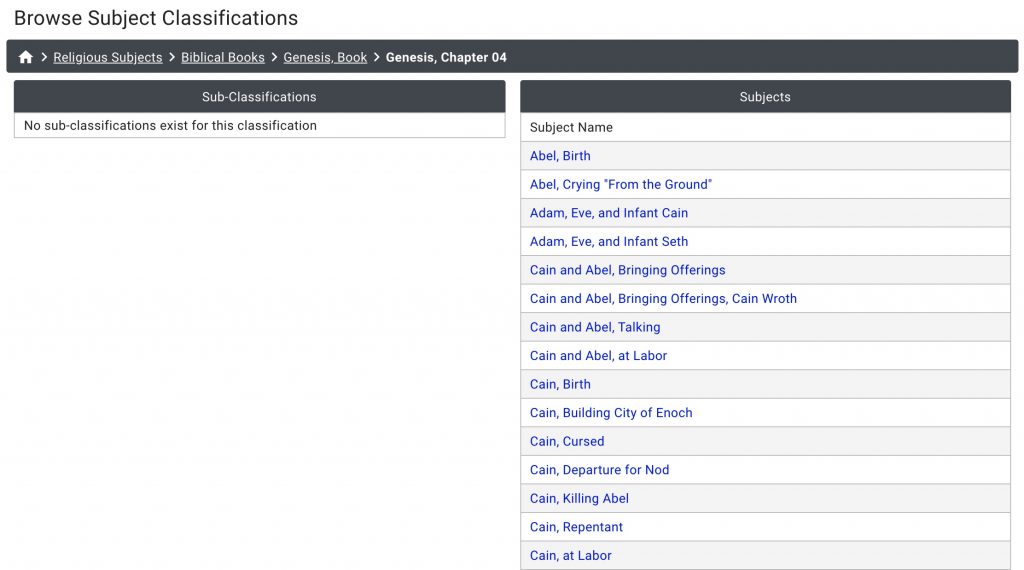
The “Society and Culture” category contains a wide variety of subject terms for representations of medieval daily life. Here you will find types of work, garments, objects, utensils, musical instruments, and furniture that the Index has identified in medieval works of art, plus an array of occupational activities, such as travel, sports, eating and feasting, and hunting scenes. Exploring the category “Sports and Games” might yield unexpected names of pastimes enjoyed in the Middle Ages. Subject terms for games such as “Chess” or “Draughts” are familiar, but others, such as “Whirligig,” might invite a deeper look.

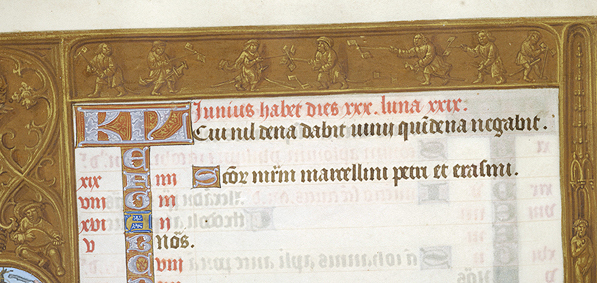
The “Nature” category is a treasure trove for anyone interested in medieval representations of animals, plants, geography, and astronomy. Here you will also find fascinating mythological creatures and hybrid figures alongside visualizations of the seasons, climate, and natural disasters. The “Symbol, Concept, and Ornament” category contains subjects for the more abstract topics in the Index collection. It currently organizes representations of allegories by name and personifications by type, including human characters for the arts, nature, places, time, virtues and vices. This category also includes maps and diagrams, monograms of individual figures, and various kinds of figured, floreate, and foliate ornament.

More a network than a strict hierarchy, the Subject Classification tool is designed to be flexible in its groupings, because the Index of Medieval Art recognizes that medieval iconography does not always fit into predetermined categories or may fit into many categories. For example, Charlemagne, the Carolingian King of the Franks and later Emperor of the Romans was also revered as a saint in some locations, so he appears in multiple parts of the network, including:
When clicking on the lowest-level subject heading, in this case “Charlemagne,” a new page will appear displaying this subject heading’s authority record. The authority record provides an array of useful information, including a Note field at the top offering a definition of the subject, or biographical details, followed by expandable fields containing select bibliographic citations, External References (cross-references to other authorities) and See Froms (alternative names and spellings of the subject). At the bottom of each subject authority is the Associated Works of Art field, an expandable field containing links to all the medieval works of art that feature this iconography.
The authority record’s Subject Classifications field presents the lowest network category, or categories, to which the subject belongs. In the example of “Charlemagne,” it is the name of the individual figure. In other instances, the Subject Classifications for a particular subject might appear on the authority as a broader grouping term. For example, the subject authority for “Drinking Horn” will use the subject classification “Utensils and Objects D–H,” and the subject for “Robin” will use the classification “Birds H–Z.” As noted in the example for biblical books, the subject classifications can also contain names of textual sources, including legends and other narratives.
The evolution of the Subject Classification tool is ongoing, allowing for continuous discovery by both those who use it and those who are building it. As branches of the network spread, new and surprising associations emerge, revealing the richness of the Index’s subject taxonomy. We hope you will enjoy browsing the iconographic headings with this new database tool, which is openly accessible to anyone who visits the browse page of the Index of Medieval Art database.
The Index of Medieval Art Subject Classifications comprises a browsable network that organizes and associates subject terms from our vast taxonomy of medieval iconography. These classifications are descriptive and not prescriptive of medieval works of art cataloged into the Index collection. What follows is an outline of the top three levels of classifications to give Index researchers the broadest overview of subject content.
Heraldry
Heraldic Symbols
Heraldry of Miscellaneous Figures and Families
Identified Heraldry A–Z
Legendary Heraldry A–Z
Historical Figures
Donors A–Z
Founders A–Z
Nobility
Those Who Fight
Those Who Pray
Those Who Rule
Those Who Work
Animals
Birds A–Z
Hunting and Other Scenes
Insects and Invertebrates
Mammals A–Z
Marine Creatures
Reptiles and Amphibians
Astronomy and Astrology
Constellations
Planets and Other Celestial Objects
Sun and Moon
Zodiac
Geography and Geology
Landscape
Minerals and Gems
Mountains
Natural Elements
Rivers
Sea and Ocean
Weather and Natural Disasters
Mythological Creatures and Hybrids
Animal Hybrids
Hybrid Figures
Mythological and Religious Creatures
Plants
Plants and Flowers A–Z
Trees and Their Fruits A–Z
Time
Months
Seasons
Times of the Day
Biblical Books
Genesis, Book–Maccabees, Book
Matthew, Book–Apocalypse, Book
Christianity
Angels and Devils
Christian Legends
Christian Objects and Rituals
Christian Religious Orders and Offices
Death and Afterlife
Divine Manifestations
Images and Attributes of Christ
Life of Christ
Life of the Virgin Mary
New Testament Apocrypha
New Testament Figures
Old Testament Apocrypha
Old Testament Figures
Saints
Types of the Virgin Mary
Greek and Roman Mythology
Mythological Figures A–Z
Mythological Narratives
Islam
Muslim Objects and Rituals
The Life of Muhammad
Judaism
Jewish Biblical Figures and Narratives
Jewish Objects and Rituals
Other Ancient Religions
Egyptian Deities
Gnosticism
Mithraism
Zoroastrianism
Architecture
Cities A–Z
Identified Buildings A–Z
Models of Buildings and Cities
Unidentified Buildings and Structures A–Z
Drollery
Drolleries and Grotesques
Figure Types
Ethnic, National, Religious, and Social Types
Figure Types A–Z
Human Hybrids
Hybrid Figures
Imaginary Figures
Labors of the Month
Months
Furniture
Bed, Bench, Lectern, Throne, etc.
Garments and Accessories
Hats, Headgear, Jewelry, etc.
Human Activities
Eating and Feasting
Hunting and Other Scenes
Medicine and Medical Practices
Occupational A–Z
Social Activities
Sports and Games
Travel and Commerce
Non-Biblical Texts
Literature and Legends
Objects and Rituals
Christian Objects and Rituals
Jewish Objects and Rituals
Muslim Objects and Rituals
Utensils and Objects
Musical Instruments A–Z
Utensils and Objects A–Z
Warfare
Arms and Armor
Military Figures
Military Scenes
Allegories and Personifications
Allegories
Personifications of Arts
Personification of Christological, Symbolic, and Literary Concepts A–Z
Personifications of Nature
Personifications of Places
Personifications of Time
Personifications of Vices
Personifications of Virtues
Maps and Diagrams
Alchemical, Alphabetical, Geometric, Astronomical Diagrams, etc. and Maps
Monogram
Monograms of Individual Figures A–Z and Symbols
Ornament
Animal, Figured, Floreate, and Foliate Ornament

This summer The Index of Medieval Art welcomed two students from the Master of Information program at Rutgers University to inventory the Index’s photographic archive. Comprising nearly two hundred thousand cards in sixteen different medium categories, this historic image collection provides researchers a rich resource of sometimes rare visual references for the study of art produced throughout the Middle Ages. The inventories undertaken by Ryan Gerber and Michele Mesi have illuminated the extent of the archive and helped to assess the image and cataloguing needs for ongoing research and cataloguing at the Index. In this special two-part blog post, we are pleased to present their observations and accounts of their experiences.
It is a testament to the Index’s stimulating power that, despite my lack of an art-historical background, I found myself entranced by the system of cataloguing medieval iconography that the Index pioneered and is still practicing to this day. Its vision of greater accessibility through complete digitization represents another milestone in its long history, and one which will be a gift to scholars of all persuasions and experience levels.
A system largely developed by Index director Helen Woodruff in the 1930s, the photographic archive is organized in the first place by medium, then by location, object type, and the numeric order within that group. Unique codes on the left-hand corner of every index card in the catalogue represent each of these levels of organization. The fruits of this labor are hard to miss after spending any time with the Index and its elegantly interwoven subject index and photographic archive, where one can move seamlessly from subject description to pictorial representations and vice versa.
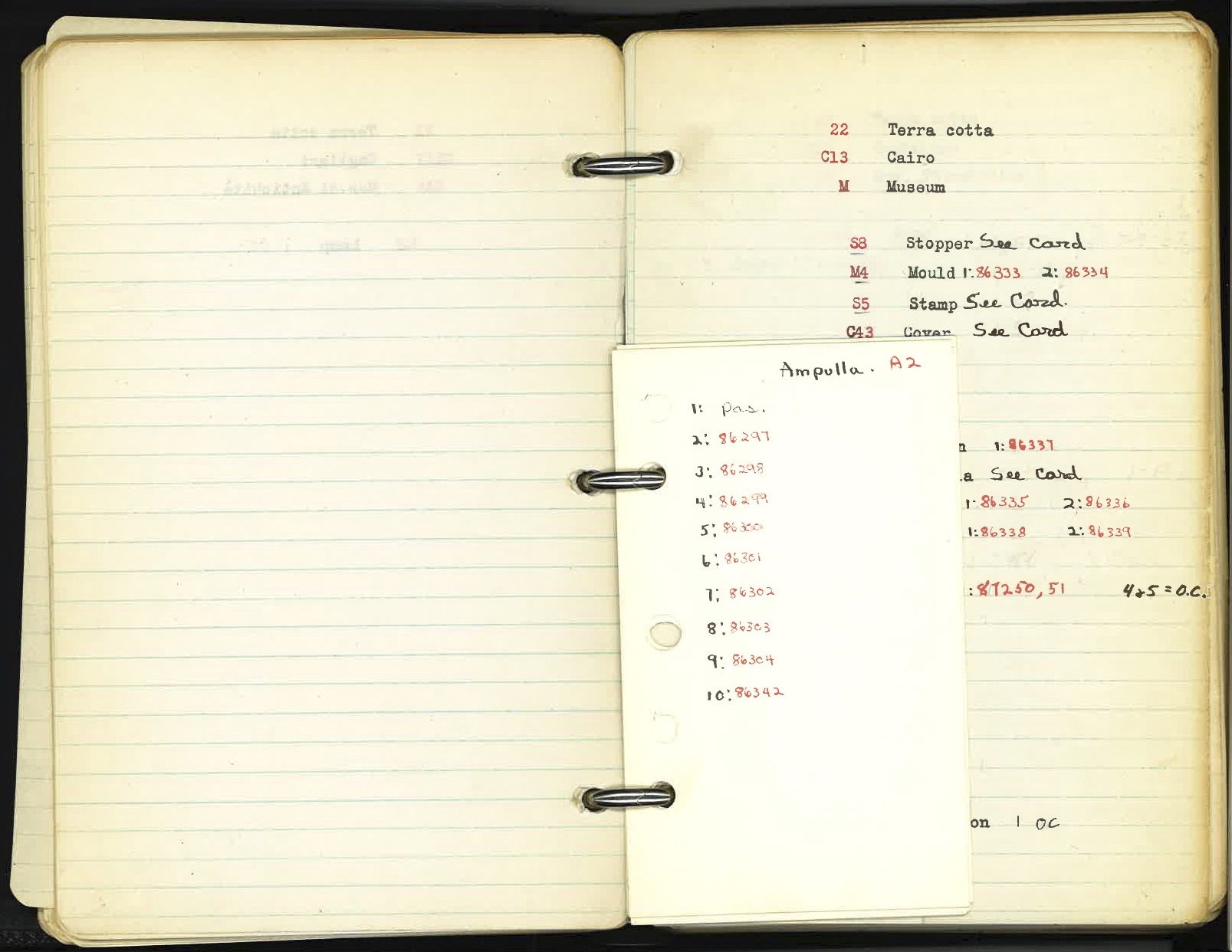
This work has also left behind a trove of archival resources such as hundreds of rolls of film and the so-called “Black Books” that were used to track the negative numbers. Each of the medium categories I inventoried not only laid the groundwork for further analysis of the collection as a whole, but highlighted the Index’s remarkable century-old ability to generate new curiosities and paths of inquiry.
Terracotta, Temporary Cards, Lamps, and Lions
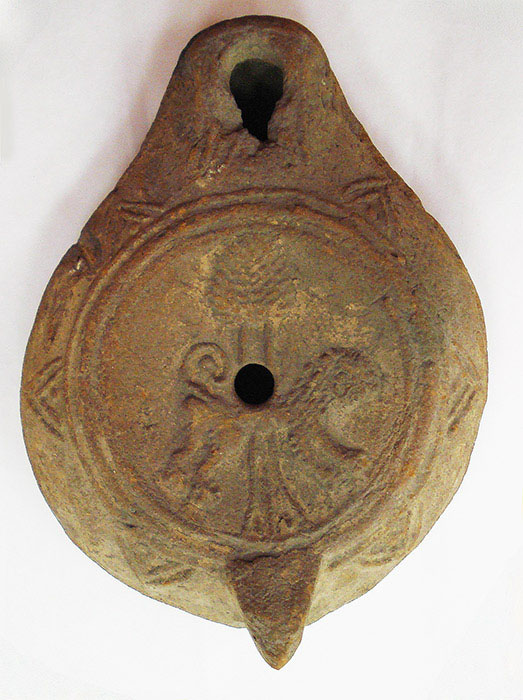
Under the medium “Terra Cotta”—a mixture of clay and water that is formed and baked or fired—the Index records more than twenty-five hundred objects across 196 locations. Of these objects, about sixty-five percent of them are oil lamps. The inventory of these files revealed some of the more common iconographic motifs found on terracotta objects, which include foliate ornament, a variety of land animals and birds, symbols such as crosses, as well as inscriptions and monograms. One terracotta lamp from the Benaki Museum in Athens depicts two of these popular motifs—a lion and a tree—combined on one impressed discus (Fig. 1).
Most photograph cards contain representations of the objects, but they also record the object’s location, the photograph’s negative numbers, subject headings for the image or images on the object, and some bibliographic information. However, there are many temporary “Orange Cards” in the archive that contain only a bibliographic reference and a subject term, and these still await corresponding images. Their inclusion in the original system nonetheless provides important data points about the objects they describe, laying the groundwork for future cataloguers to source the images for these object records. For example, the Index’s photo archive of terracotta objects in the National Museum at Carthage is mostly Orange Cards because the original Index records of these objects derive from a 19th-century publication with very few illustrations. While it would be useful to see images of the “lions” held at the National Museum in Carthage, even in the absence of photographs it may be just as useful to know that, of the 970 terracotta lamps held in that location, nearly four hundred depict animals, and about sixty-five of those include a lion.
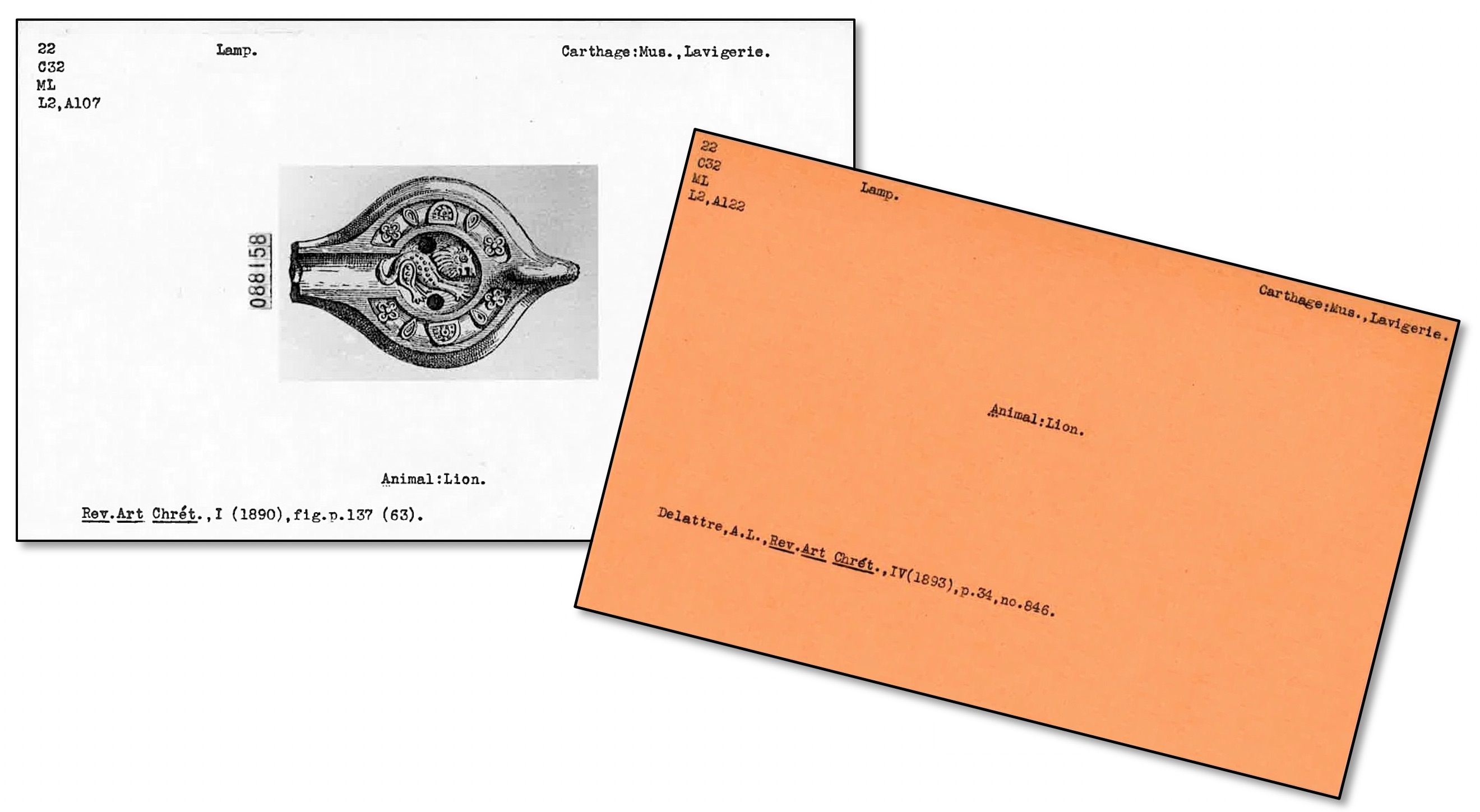
A Face in Gold Glass
The “Gold Glass” files record over 650 objects across sixty-three locations dating mostly from late antiquity between the 3rd and 7th centuries. Of these objects, nearly half are vessels of some kind. Gold glass developed as a medium in the ancient Roman and Hellenistic periods and consisted of decorative engravings made in gold leaf, which were then sandwiched between fused layers of glass. The result was lavish decoration, and exemplary pieces in this medium offer strikingly detailed portraits of their subjects, often depicting married pairs, family groups, or religious figures associated with one another, such as Saints Peter and Paul. Historians have noted the rarity of gold glass, as well as its costly, specialized method of production.[1]
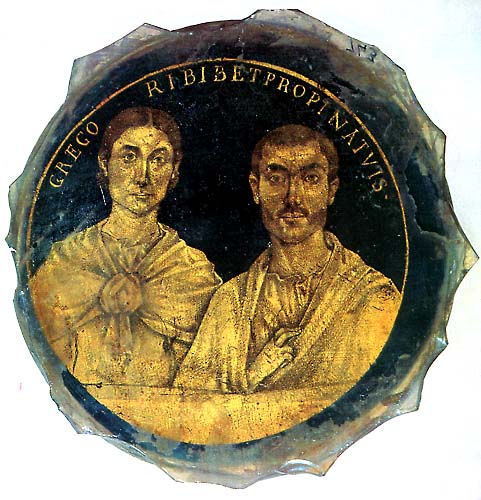
Gold glass was a special interest of Index founder Charles Rufus Morey, and his pioneering catalogue of the Vatican Library’s collections features as its first entry an example also catalogued by the Index. It shows the busts of a married couple inscribed above with the name Gregori and a Latin equivalent of “cheers!”: “Gregori bibe [e]t propina tuis,” or “Gregory, drink and drink to thine!” (Fig. 2).[2]
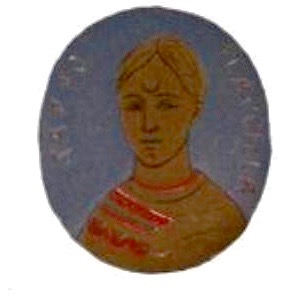
Another interesting discovery in the “Gold Glass” category was a round vessel fragment last recorded in the Cabinet des Médailles in Paris. It depicts a striking bust of a figure with shorn hair, dressed in a trimmed tunic, and with a distinctive crescent shape on their forehead. The only other information on the photograph card was the source of the image, the antiquities catalogue that Anne-Claude-Philippe de Caylus published in seven volumes from 1756 to 1767.[3] Caylus’s catalogue was a valuable starting point for identifying this figure, whose iconographic description had not been entered in the Index’s subject files or the database. A little more searching led to a color image in a French catalogue, the Histoire de l’art de la Verrerie dans l’Antiquité (Fig. 3), and to the conclusion that the inscription “SAPPO FLACILLAE”—with the genitive form of the empress’s name—referred to a branded enslaved person who had been freed by the Roman Empress Aelia Flacilla (356–386). We also used the photo-editing web application Pixlr to create a positive image of “Sappo” so that the image from the Index archive can now be seen as it appeared in the catalogue of the comte de Caylus (Fig. 4).
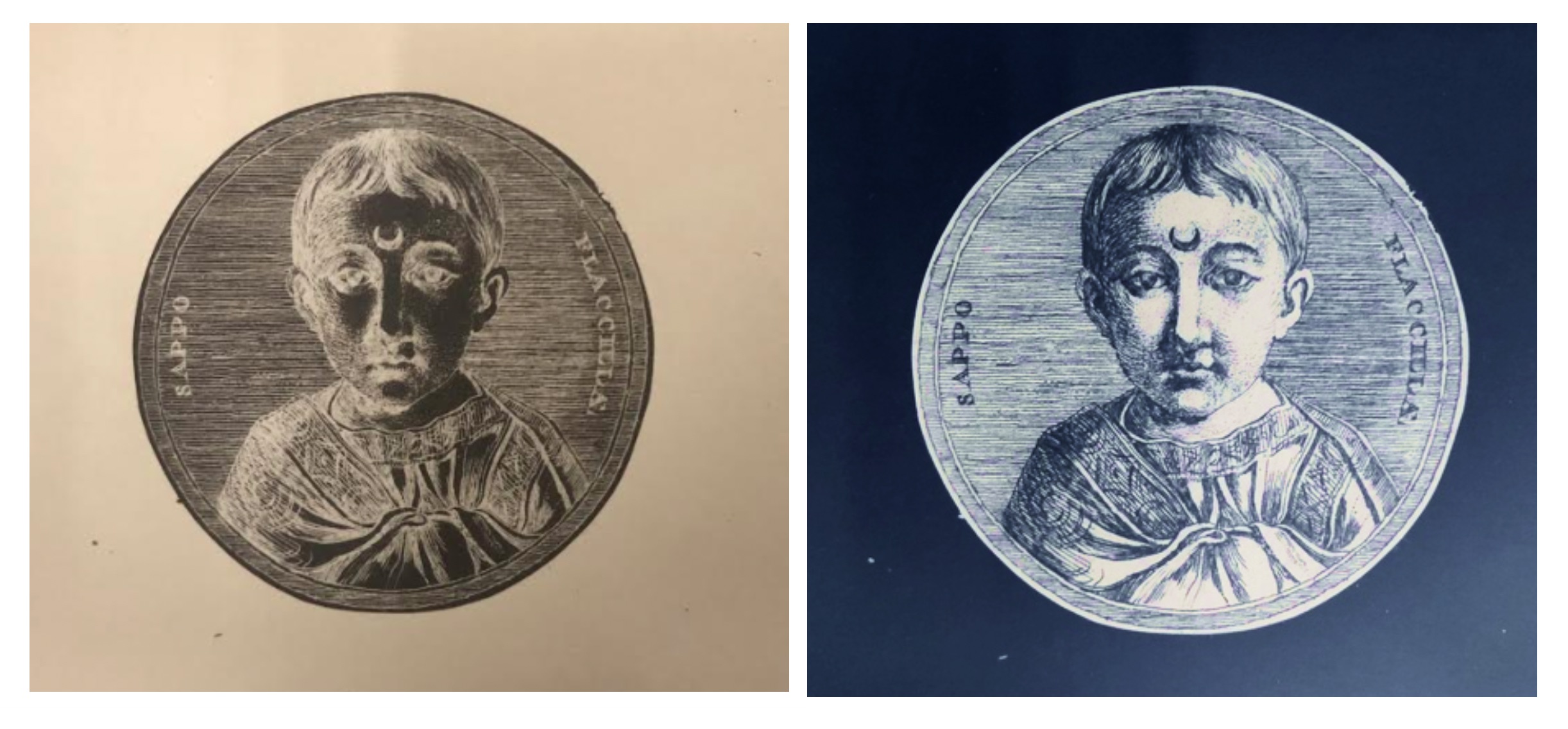
Impressions in Wax
Comprising a little over one thousand objects in 105 locations, the “Wax” medium files are overwhelmingly made up of stamps from Europe dating largely to the 13th and 14th centuries. Although the archive groups these objects into the single object category “Stamp,” the Index database divides them into two Work of Art Types, “Seal Matrix” (that is, the tool used to make the impression) and “Seal Impression” (that is, an impression made by a matrix).[4] Viewing about a thousand examples of Gothic seals intended for both religious and secular officialdom brought into literal relief the development of the production of seal dies from simple figural representations to complex ecclesiastical chapters in miniature, such as the Stamp of Ely Priory, dated to about 1240–1260 (Fig. 5). Other favored subjects in wax seals include heraldry, nobles, and popular saints and bishops, like Thomas Becket. The wealth of iconographic information in the “Wax” files—indeed throughout the archive—emphasizes that the Index is not a closed system, and has at every turn great potential for leading one into new areas of inquiry.
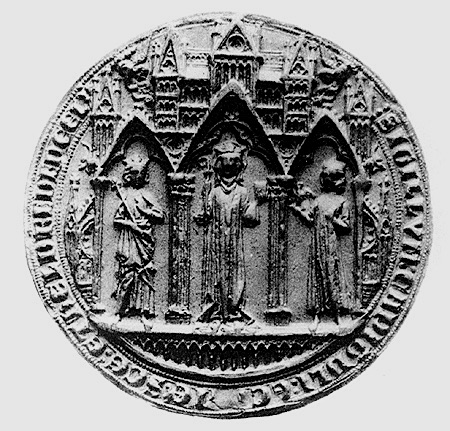
Ryan Gerber is a graduate student at Rutgers University studying Information Science with a concentration in Archives and Preservation. He holds an MA in English from The College of New Jersey with a concentration in Medieval and Early Modern Literature. His interests include digital preservation and retrieval, the digital humanities, and information behavior.
See Part 2 written by Michele Mesi.
[1] Giulia Cesarin, “Gold-Glasses: From their Origin to Late Antiquity in the Mediterranean,” in Things that Travelled: Mediterranean Glass in the First Millennium AD (London: UCL Press, 2018), 22–45.
[2] Morey noted of the inscription that “the E of ‘bibe’ or of ‘et’ [was] omitted by mistake.” Charles Rufus Morey, The Gold-Glass Collection of the Vatican Library (Vatican City: Biblioteca Apostolica Vaticana, 1959), 1. Translation after Georg Daltrop in Leonard von Matt, Georg Daltrop, and Adriano Prandi, Art Treasures of the Vatican Library (New York: Abrams, [1970]), 168.
[3] Anne-Claude-Philippe de Caylus, Recueil d’antiquités égyptiennes, étrusques, greques, romaines et gauloises (Paris, 1756–57), 193–205, pl. 53.2, https://archive.org/details/recueildantiquit03cayl/page/n10.
[4] See the Index database Work of Art Type browse list to access these Work of Art References.

Precious Gems Containing a Wealth of Iconography

“Glyptic” is among the smaller medium categories in the Index archive, filling only one drawer with a little more than eleven hundred cards that record only about nine hundred objects. The term “glyptics” refers the art of carving gems or seals—whether in intaglio or in relief—typically in gems or precious stones such as jasper, agate, carnelian, and amethyst.[1] This form of art is one of the oldest—known since the Mesopotamian, Egyptian, and Assyrian civilizations—but it was not until the Hellenistic period that relief cameos, seals, and more intricate glyptic objects began to appear.[2]
Glyptics, which were often worn as jewelry or incorporated into ecclesiastical objects, are recorded in the Index primarily as gems, amulets, plaques, rings, and stamps, and the largest category, cameos, which makes up nearly a third of the glyptic objects in the Index files. A significant portion of the subjects on these carved gems include animals and plant life, like doves, dolphins, fish, palm trees, and fantastic creatures. There are other symbols as well, such as the anchor, which appears on over forty examples. A significant number of glyptics incorporate classical and mythological figures, such as Orpheus, Diana, Jupiter, and Hecate. Nearly twenty cards for gem objects record the Gnostic figure Abrasax (Fig. 1). Glyptics such as these were powerful talismans for their owners.
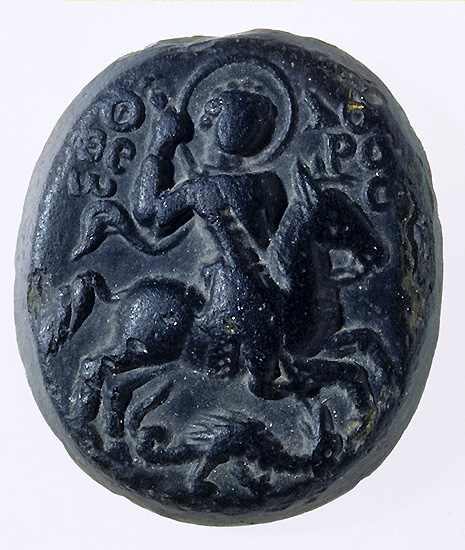
The traditional use of spiritual amulets was also adopted by Christians using Christian symbols and themes.[3] Christian iconography on glyptics include the triumphant Archangel Michael or Saint George, Daniel in the Lion’s Den, and the Good Shepherd. One cameo of opaque black glass made in the 13th century depicts Saint Theodore transfixing the dragon and well represents the preference for saintly imagery on later cameos (Fig. 2).[4] The inventory also revealed that there were nearly thirty examples of incised depictions of monograms on glyptics with a third of them being the Chi-Rho, a symbol for Christ consisting of the first two letters of the word “Christos” (Christ) in Greek.
The major collections represented in this medium include the Staatliche Museen in Berlin (over eighty objects) and the British Museum in London (nearly 125 objects. However, a large number of glyptics (over 140 objects) are recorded as “Location Unknown,” these items having been entered into the Index from major publications that did not provide the precise location at the time of publication.
Radiant Ivories for Both Secular and Religious Narratives

With nearly forty-seven hundred cards covering a little over thirty-one hundred objects, Ivory represented a more extensive category in this inventory project. The types of ivory objects recorded by the Index range from plaques, chess pieces, croziers, and triptychs to the more unusual oliphant (or hunter’s horn) to the handles of various utensils, and even a saddle. Some of the major collections represented in this medium are the Musée du Louvre and the Musée de Cluny in Paris, and the British Museum and the Victoria and Albert Museum in London. Ivory objects were expertly carved in minute detail, usually from the tusks of elephants. In the Index database, ivory acts as a “parent medium,” an umbrella covering such materials as bone, walrus tusks, and antlers.[5]
Various motifs of courtly love were often depicted on ivory caskets, plaques, mirror cases, combs, and other fine domestic objects.[6] A preference for secular subjects on ivories emerged in the twelfth century when an influx of secular imagery was brought to Europe from the Middle East after the Crusades, as well as through a rise in vernacular literature, legends, and romances.[7] Entertaining stories such as the tale of the Virgin and the Unicorn provided plenty of thematic material to adorn precious ivory objects. They often offered a double meaning or moral lesson, as in the story of Tristan and Isolde depicted on an early 14th-century ivory casket now in the Metropolitan Museum of Art, which warns against temptations of lust (Fig. 3).[8]
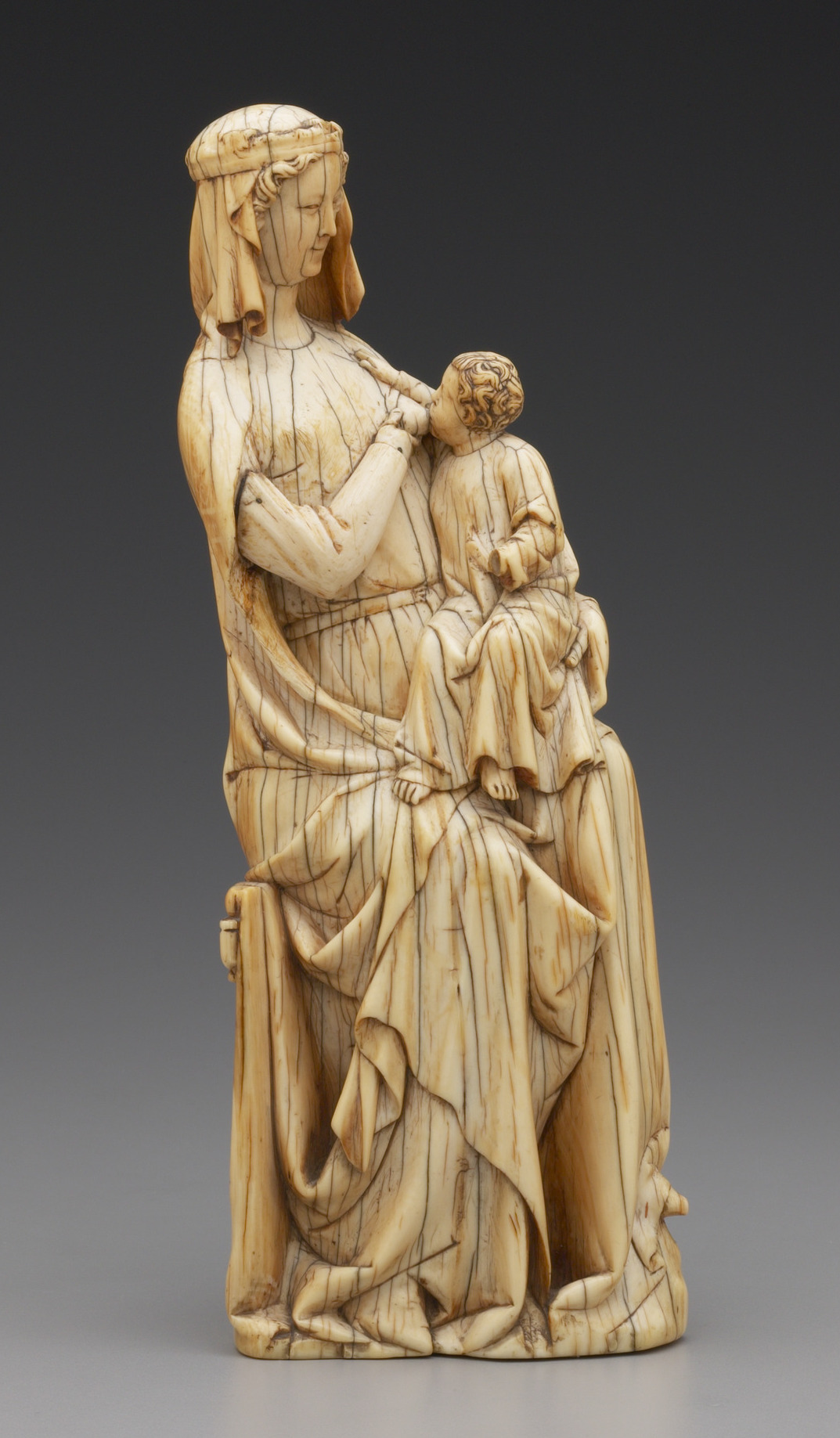
Despite their popularity, secular ivories are fewer in number than devotional works of art in ivory. Roughly a quarter of the ivory objects recorded in the Index are representations of the Virgin Mary and the Christ Child. This figure rises to more three quarters when we add individual figures of Christ or the Virgin Mary. One type seen rather frequently is that of the Virgin nursing the infant Christ—known in Latin as the Virgo Lactans—which the Index categorizes among the many “types” of the Virgin Mary and Christ Child. In the database, the subject heading Virgin Mary and Christ Child, Suckling Type is attached to over 290 Work of Art records. More than forty of these are ivory. This Virgo Lactans iconographic type is exemplified by a 14th-century ivory statuette in the Yale University Art Gallery, which displays an intimate and lifelike relationship between mother and child (Fig. 4). Thus, the devotional message is made personal.
The Project Continues …
Encompassing eight drawers of roughly one thousand cards each, “Painting” proved to be an abundant medium, but “Illuminated Manuscript” is by far the largest medium category in the Index, filling fifty-six of the photograph drawers. Medieval art objects encountered in these two categories range from painted icons and altarpieces to a wide variety of liturgical manuscripts and other illuminated books numbering perhaps in the thousands. The inventory of these and other remaining categories—including those comprising in situ works of monumental art, such as “Mosaic” and “Fresco”—will continue after this summer.
As a “living archive” that covers more than a millennium of artistic creation, the Index of Medieval Art has always been improved and expanded by the interactions of the cataloguers who create it with the with researchers who use it. Creating these inventories has been an illuminating way to participate in that process and to learn more about the contents of the Index card catalogue being prepared for entry into the online database. This project was challenging at times, due to the sheer breadth of the paper files, but it has been an invaluable undertaking for the ongoing process of research and digitization, and will improve accessibility to the records contained in this century-old archive of medieval art.
Michele Mesi is a graduate student at Rutgers University studying Information Science with a concentration in Archives and Preservation. From Rutgers University, she also holds a Bachelor’s degree in English with studies in Art History and in Digital Communication, Information, and Media. Her interests include art conservation, archival processing, and working with rare books and manuscripts.
See Part 1 written by Ryan Gerber.
[1] The Index of Medieval Art follows the standards for material description established by the Getty Art & Architecture Thesaurus (AAT). See the Art & Architecture Thesaurus® Online, https://www.getty.edu/research/tools/vocabularies/aat/.
[2] O. Neverov and A. Durandin, Antique Intaglios in the Hermitage Collection (Leningrad: Aurora Art Publishers, 1976), 7.
[3] Neverov and Durandin, Antique Intaglios, 8.
[4] The Index records the iconography in question as Theodore Tyro or Theodore the General, Slaying Dragon.
[5] See the glossary entry on the Index database Medium browse list for “ivory.”
[6] J. Lowden and J. Cherry, Medieval Ivories and Works of Art: The Thomson Collection at the Art Gallery of Ontario (Art Gallery of Ontario, 2008), 122.
[7] R. H. Randall, “Popular Romances Carved in Ivory,” in Images in Ivory: Precious Objects of the Gothic Age (Detroit Institute of the Arts, 1997), 63.
[8] Randall, “Popular Romances,” 67–68.
The ways in which scholars research the iconographic traditions of the Middle Ages is continuously evolving. In order to address this, the Index of Medieval Art organized and sponsored a roundtable, Encountering Medieval Iconography in the Twenty-First Century: Scholarship, Social Media, and Digital Methods, at the 54th International Congress on Medieval Studies at Western Michigan University in Kalamazoo. The five panelists briefly presented on the ways in which they incorporated iconography into their teaching, research, and curatorial work. They then participated in a discussion of how they use and develop online resources, such as image databases, to reach students and researchers. The result was a lively dialogue about how digital approaches can make medieval iconographic study more accessible to a diverse, global audience.

One of the first topics of discussion was the avenues by which viewers encounter medieval iconography in the twenty-first century. Anne Stanton, Associate Professor of Art History at the University of Missouri, raised the point that popular social media outlets and online databases are often the first portals through which many students gain access to medieval images and learn about subject matter in works of art. Many institutions have responded to this this fact by using social media platforms to broaden interest in iconography and connect users to works of art. The many vibrant examples of social media use in the field, ranging from museums to libraries, include the Getty, Dumbarton Oaks, and the British Library. Sabine Maffre, Curator of the Mandragore Database at the National Library of France, discussed developments at the library’s blog Gallica, which has been inviting professional bloggers to write posts about illuminations in order to diversify their audience and make their medieval image collections more visible.

Beyond questions of access, another change has occurred in the ways in which we think about iconography. Konstantina Karterouli, postdoctoral fellow and graduate of Harvard University, presented an Artificial Intelligence (AI) project that the Dumbarton Oaks Research Library & Collection is developing with the goal of teaching computers to recognize the different architectural elements of a medieval building. Commenting on the wider potential of this approach, Maffre also noted that the Bibliothèque nationale de France (BnF) staff have been working toward implementing automatic recognition of manuscript illuminations through AI. A contrasting approach to iconography, presented by Isabelle Marchesin of the Institut national d’histoire de l’art (INHA) at the Sorbonne in Paris, faces head-on the problem of offering something that AI still cannot provide: interpretations of specialized content. The OMCI (Ontology of Medieval Christianity in Images) project, founded and developed by Marchesin, is based on the concept that, beyond narrative and portraits, Christian medieval images implicitly refer to another level of signification that is ontological and strongly connected in this case to theology as a holistic system of explanation of the world.

One important takeaway from the roundtable was the recognition that the role of the iconographer itself is changing. As Professor Marina Vicelja of the University of Rijeka emphasized, rather than requiring the solitary work so often undertaken in the past, it could and should be seen in light of collaborations, interdisciplinary research, and international networks. A starting point could be the implementation of cross-discoverable databases, shared standardized vocabularies, and the use of platforms like Biblissima, a digital library and widely interoperable data cluster designed to gather and give access to the main iconographic and textual databases. These ideas inspired discussion of the difficult balance between the strategies used by database specialists and the kinds of usability expected by twenty-first century researchers. Karterouli strongly emphasized the importance of standardization in these endeavors to help retrieve information, and Vicelja stressed the necessity of integrating metadata in order to avoid misunderstandings.
In the twenty-first century, we find ourselves at a crossroads between traditional methods of iconographic study and the implementation of pioneering technologies such as AI. The potential for interoperable platforms to enhance the research experience could answer new expectations with new possibilities. While it can be difficult to strike a balance between time-tested approaches and new ideas, the tension is proof that the study of iconography is very much alive and evolving. We hope that the Index roundtable at Kalamazoo was only the first word in a vibrant and expansive dialogue among an international community of creators and consumers of information about medieval iconography.